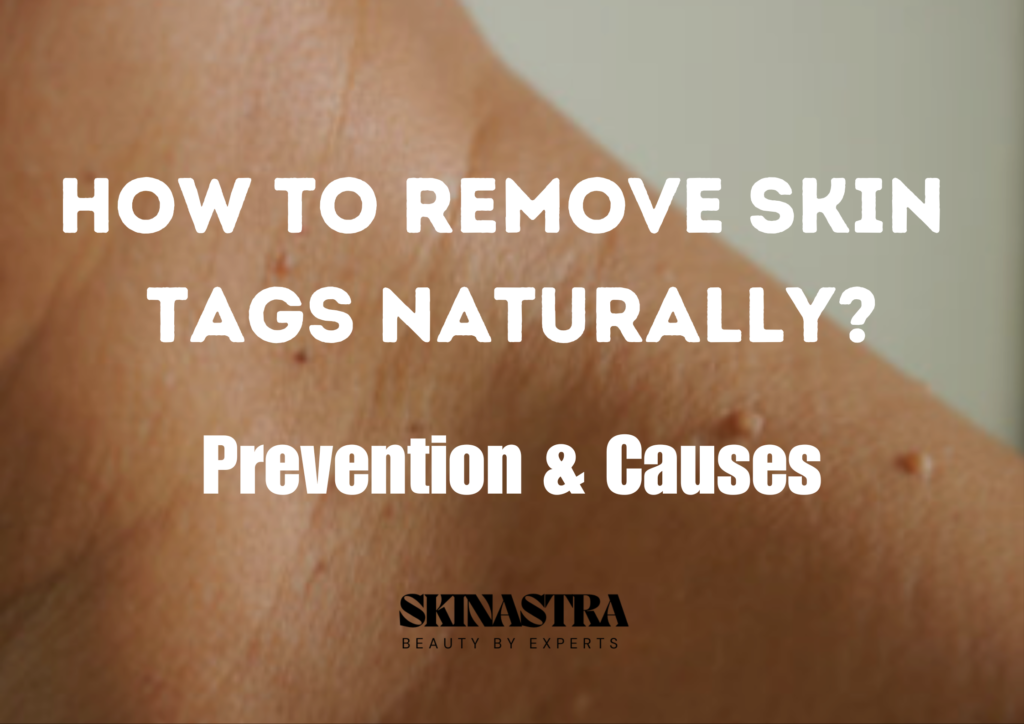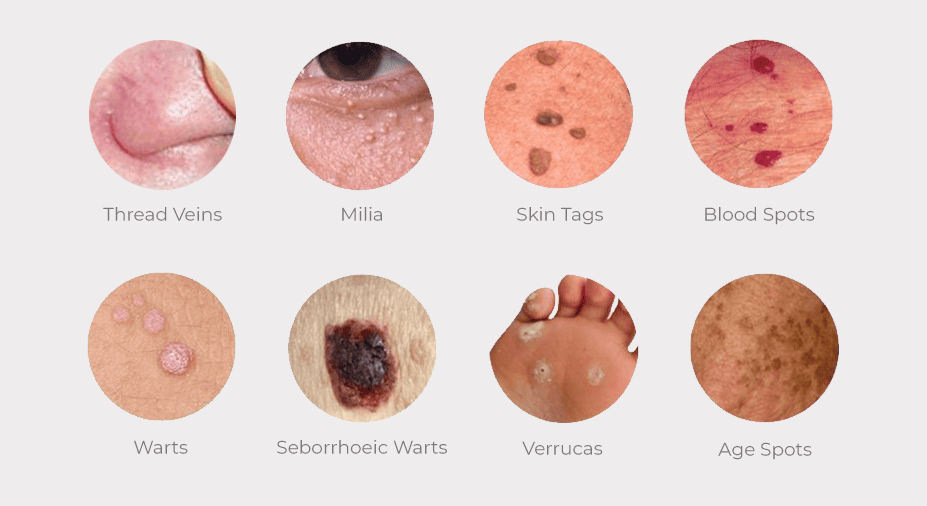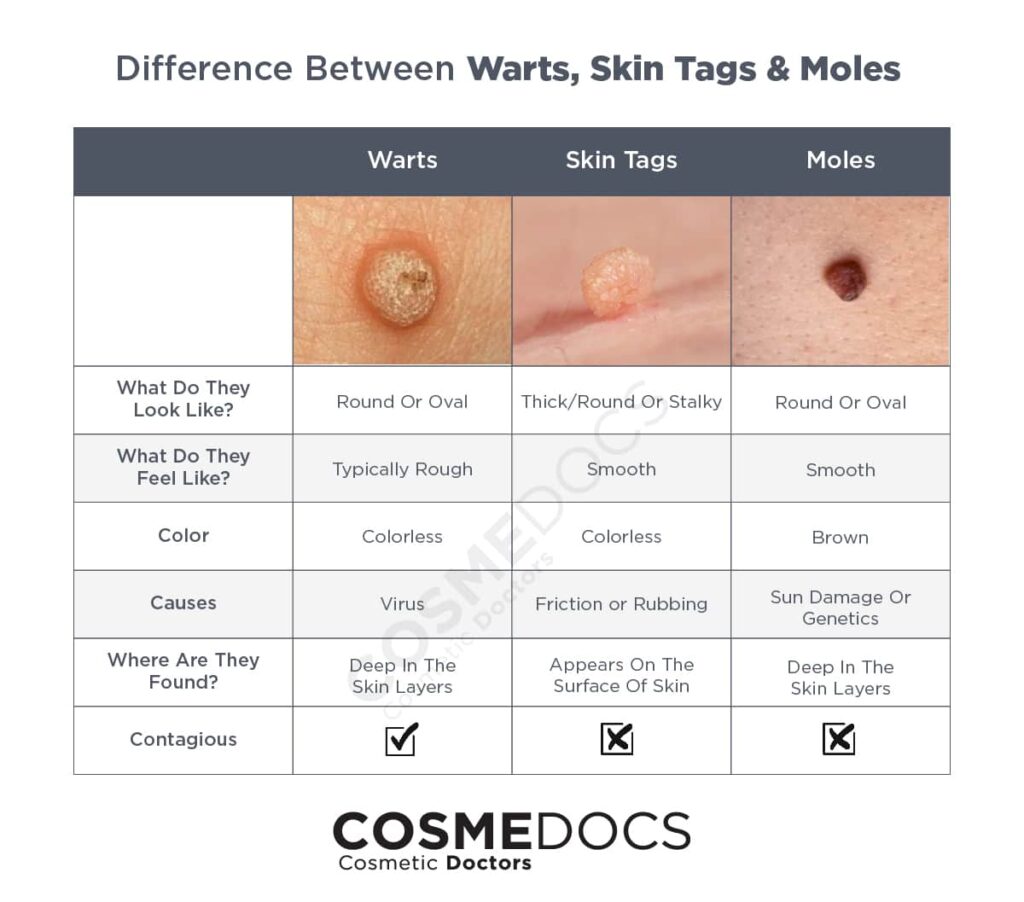Have you ever noticed those small, fleshy growths on your skin that seem to pop up out of nowhere? Well, you’re not alone. Those little annoyances are called skin tags, which are more common than you think. While they may not be harmful, they can be bothersome and affect our self-confidence.

Today, we’ll explore skin tags, their causes, how to remove skin tags naturally, and the various treatment options available. So, let’s get to the bottom of these pesky-skin companions and find out how to deal with them effectively!
Table of Contents
Remove Skin Tags Naturally | What Skin Tags Are Caused By?
Skin tags, also known as acrochordons, are small, benign growths that typically appear on the skin. While the exact cause of skin tags is not fully understood, several factors are believed to contribute to their development. It’s important to note that skin tags are harmless and do not usually require medical treatment unless they cause discomfort or are aesthetically bothersome.
- Skin Friction and Rubbing: Skin tags often develop where the skin frequently rubs against other skin or clothing. Common locations include the neck, underarms, groin, and eyelids. Friction and rubbing can lead to the formation of skin tags over time.
- Genetic Factors: Evidence suggests a genetic predisposition to developing skin tags. You may be more prone to developing skin tags if you have a family history of skin tags. Specific genes and inherited traits may play a role in their development.
- Hormonal Changes: Hormonal fluctuations in the body can influence the formation of skin tags. Pregnant women often experience hormonal changes that can contribute to the development of skin tags. Similarly, individuals with hormonal imbalances, such as those associated with diabetes or obesity, may be more susceptible to skin tag formation.
- Age: Skin tags are more commonly observed in middle-aged and older individuals. As we age, the likelihood of developing skin tags increases. However, they can occur at any age, including in children and teenagers.
- Obesity and Excess Weight: Being overweight or obese is a risk for developing skin tags. Excess weight can increase friction between skin folds, allowing skin tags to grow more quickly.
- Human Papillomavirus (HPV): Some research suggests a potential link between certain strains of HPV and the development of skin tags. However, the connection still needs to be fully understood, and more studies are required to establish a definitive relationship.

Symptoms and Signs to Look Out for with Skin Tags
Skin tags are characterized by their small, soft, and often flesh-colored appearance. They typically range from a few millimeters to a few centimeters in diameter. These growths commonly have a stalk-like or pedunculated shape protruding from the skin’s surface. However, it’s important to note that skin tags can vary in appearance, and some may be flat or slightly raised without a visible stalk.
The location of skin tags is often associated with areas of the body with friction or rubbing. Common sites include the neck, underarms, groin, eyelids, and underneath the breasts in women. However, they can develop on any part of the body. It’s not uncommon for people to have multiple skin tags in various locations.
In terms of texture, skin tags are generally soft and smooth to the touch. They are composed of loose collagen fibers and blood vessels enclosed within a thin layer of skin. Unlike moles or warts, skin tags do not have a rough or warty texture. Instead, they typically have a pliable and non-irritating feel.
Skin tags are usually painless and do not cause discomfort. However, if a skin tag becomes irritated due to friction or rubbing against clothing, jewelry, or other objects, it may become sensitive or tender. Skin tags may twist in rare cases, leading to pain or discomfort. If this occurs, seeking medical attention to address the issue is advisable.

It’s worth noting that skin tags are generally harmless and do not pose any significant health risks. However, if you notice sudden changes in the size, color, or appearance of a skin tag, or if it becomes painful, bleeds, or shows signs of infection, you should consult a dermatologist for further evaluation and the proper treatment.
Can Skin Tags Be Cancerous?
No, skin tags are generally not cancerous. They are benign growths that pose no significant health risks. Skin tags are composed of normal skin tissues, including collagen fibers, blood vessels, and a thin layer of skin.
Cancerous growths, such as malignant melanoma or squamous cell carcinoma, have distinct characteristics and differ in appearance from skin tags. Skin tags are typically small, soft, and flesh-colored or slightly darker. They have a smooth or somewhat wrinkled surface, often hanging from the skin by a thin stalk.
However, it’s important to note that there are rare cases where a growth may be mistakenly identified as a skin tag but is actually a skin cancer or another abnormal skin lesion. If you notice any changes in the appearance of a skin tag, such as rapid growth, bleeding, ulceration, or irregular borders. In that case, it is recommended to consult a dermatologist for proper evaluation and diagnosis.
Regular self-examination of your skin and routine visits to a healthcare professional is essential for detecting any suspicious or concerning skin growth. If you have any doubts or concerns about a skin tag or other skin condition, it is always best to seek medical advice for a proper diagnosis and appropriate treatment.
Are Skin Tags Contagious Or Bad?
Skin tags are not contagious. They are harmless growths that an infection or a contagious agent does not cause. You cannot contract skin tags from someone else or transmit them to others through direct contact.
Skin tags are generally considered harmless and not medically concerning regarding their impact on health. They do not pose any significant health risks or complications. Skin tags are typically painless unless they become irritated due to friction or rubbing against clothing or jewelry. While they can be bothersome from a cosmetic perspective, they do not cause significant health problems.

However, it’s important to note that a healthcare professional should evaluate any changes in the appearance or characteristics of a skin tag. In rare cases, a skin growth that appears to be a skin tag may be a different skin condition or require further investigation.
Remove Skin Tags Naturally | Home Remedies And Over-The-Counter Treatments
Tea Tree Oil
Tea tree oil is known for its antiviral, antifungal, and drying properties. When applied to the skin tag, it can help dry out the tag and cause it to shrink over time. The antiseptic properties of tea tree oil also help prevent infection during the process.
- Dilute tea tree oil with a carrier oil, like coconut or olive oil, to reduce the risk of irritation.
- Apply the diluted tea tree oil to the skin tag using a cotton swab or a clean cloth.
- Repeat this process a few times a day until the skin tag dries up and falls off.
Apple Cider Vinegar
Apple cider vinegar is slightly acidic and can cause a mild chemical burn when applied to the skin. This acidity can gradually break down the cells in the skin tag, leading to its eventual shrinking and falling off. It’s essential to avoid skin irritation when using this method.
- Soak a cotton ball in apple cider vinegar.
- Apply the soaked cotton ball to the skin tag and secure it in place with a bandage.
- Leave it on for several hours or overnight.
- Repeat daily until the skin tag darkens, dries, and falls off.
Over-the-Counter Topical Products
Many over-the-counter products designed for skin tag removal contain active ingredients like salicylic acid. Salicylic acid is a keratolytic agent that helps break down the cells that make up the skin tag. Regular application of such products can cause the skin tag to disintegrate gradually.
- Look for OTC products specifically designed for removing skin tags. They often contain ingredients like salicylic acid.
- Follow the instructions provided on the product packaging carefully.
- Apply the product to the skin tag, and it will work by gradually breaking down the cells of the tag.
Ligation Devices
Over-the-counter ligation devices tightly bind the skin tag’s base, constricting blood flow. Without a blood supply, the skin tag’s cells die off, leading to its detachment from the skin. The tag should fall off after some time.
- Some OTC ligation devices are designed to cut off blood supply to the skin tag.
- Follow the instructions provided with the device to use it safely.
- Over time, the skin tag should dry up and fall off.
Dental Floss or Thread
Tying a piece of dental floss or thread around the base of the skin tag cuts off its blood supply. This process is called ligation. Without a blood supply, the skin tag’s cells cannot receive the nutrients and oxygen they need, causing the tag to eventually wither and fall off.

- Clean the area and the skin tag, then dry thoroughly.
- Tie a piece of dental floss or thread around the base of the skin tag, ensuring it’s tight but not too constricting to cause pain.
- The goal is to cut off the blood supply; the skin tag should fall off after several days to a week.
Baking Soda and Castor Oil Paste
Baking soda exfoliates, and castor oil moisturizes. This paste can help break down the skin tag’s cells while moisturizing the area, promoting cell breakdown and detachment over time.
- Mix baking soda with castor oil to form a paste.
- Apply the paste to the skin tag and cover with a bandage.
- Leave it on overnight, then rinse in the morning.
- Repeat until the tag dries out and falls off.
Lemon Juice
Lemon juice’s natural acidity can break down cells. The citric acid in lemon juice can weaken the skin tag’s cells, promoting its gradual breakdown and detachment.
- Apply freshly squeezed lemon juice to the skin tag using a cotton ball.
- Let it dry, then rinse.
- The natural acidity of lemon juice may help break down the tag’s cells over time.
Banana Peel
Enzymes in the banana peel may aid in cell breakdown. While the evidence is limited, some believe that enzymes in the banana peel might help break down the skin tag’s cells, leading to its detachment.
- Cut a small piece of banana peel.
- Place the inside of the peel against the skin tag, securing it with a bandage.
- Leave it on overnight and repeat as needed.
- Some people believe the enzymes in the banana peel can help remove the skin tag.

Remember these points while trying natural methods:
- Always clean the area before applying anything.
- Discontinue if you experience irritation, pain, or infection.
- Results may take time; be patient and consistent.
- Consult a medical professional if the tag doesn’t respond to natural treatments or causes concern.
While natural methods can work for some people, professional removal or a clinically tested skin tag removal product might be the safest option, especially for larger or sensitive skin tags. Consulting a dermatologist ensures proper diagnosis and safe removal with minimal risk of complications.
Frequently Asked Questions About Skin Tags
Can Skin Tags Grow Back?
Yes, skin tags can potentially grow back after removal. While removal methods may eliminate the existing tag, new skin tags can develop in the same area or elsewhere due to genetics, friction, and hormonal changes. Regular skin care and monitoring can help manage their occurrence.
Are Skin Tags Genetic?
Yes, there’s a genetic predisposition to developing skin tags. Family history and genetics can play a role in their formation. Factors like obesity, hormonal changes, and friction also contribute. You might be more prone to developing skin tags if you have a family history of skin tags. However, their exact cause still needs to be fully understood.
Can Skin Tags Fall Off Themselves?
Well, yes, skin tags can sometimes fall off themselves. This can happen if they are subjected to friction or clothing rubbing against them, causing them to wear away gradually. Additionally, as a thin stalk connects skin tags, they may naturally detach when their blood supply is cut off. However, this can be a slow process, and many people choose to have them removed for cosmetic or comfort reasons.
Can Skin Tags On Eyelids Be Removed?
Yes, skin tags on eyelids can be removed, but it’s recommended to have this done by a qualified medical professional, such as a dermatologist or an ophthalmologist. Removing skin tags on the eyelids requires special care to avoid injury to the delicate eye area. Professionals may use cryotherapy, surgical excision, or electrocautery to remove eyelid skin tags safely. It’s vital to seek expert advice to ensure the procedure is performed safely and with minimal risk to your eye health.

Why Skin Tags During Pregnancy?
Skin tags during pregnancy are thought to be influenced by hormonal changes. Increased levels of hormones like estrogen and progesterone can lead to excess skin growth, including skin tags. Friction caused by weight gain and skin folds also plays a role. However, these skin growths tend to be harmless. After pregnancy, hormonal levels may return to normal, and some skin tags might naturally shrink or fall off.
Are Skin Tags Contagious?
No, skin tags are not contagious. They are benign growths of skin that develop due to factors like genetics, hormonal changes, and friction. Viruses or bacteria do not cause skin tags and cannot be spread from person to person through contact. They are considered harmless and do not pose a risk of transmitting any infections.
When Skin Tags Bleed And Go Black?
If a skin tag becomes twisted or irritated, it can lead to a disrupted blood supply, causing it to bleed and turn black. The twisting can cut off circulation to the tag, resulting in tissue death (necrosis). The color change is due to the lack of blood flow and oxygen. While this might cause concern, it often indicates that the skin tag is detaching naturally. If bleeding is excessive or significant discomfort, it’s wise to consult a healthcare professional for assessment.
Closure
In wrapping up this comprehensive exploration of skin tags, it’s clear that these benign growths are a common occurrence, often stemming from a blend of genetic predisposition, hormonal fluctuations, and friction. While generally harmless, their presence can lead to discomfort and self-consciousness. I’ve delved into various aspects, including home remedies and over-the-counter treatments to remove skin tags naturally.
However, it’s vital to approach these methods cautiously, as risks like infection and scarring exist. Seeking advice from a medical professional remains the most prudent path, especially for skin tags situated in sensitive areas. Understanding the practical options and potential complexities equips us to make informed choices about our skin’s well-being.
